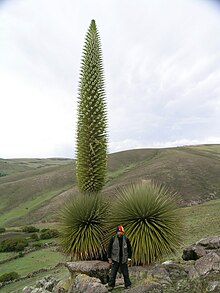Puya raimondii
| Puya raimondii | |
|---|---|
 |
|
| Puya raimondii flowering in Ayacucho, Peru. | |
| Scientific classification | |
| Kingdom: | Plantae |
| (unranked): | Angiosperms |
| (unranked): | Monocots |
| (unranked): | Commelinids |
| Order: | Poales |
| Family: | Bromeliaceae |
| Genus: | Puya |
| Species: | P. raimondii |
| Binomial name | |
|
Puya raimondii Harms |
|
Puya raimondii, also known as queen of the Andes (English),titanka (Quechua) or puya de Raimondi (Spanish), is the largest species of bromeliad. It is native to Bolivia and Peru and is restricted to the high Andes at an elevation of 3000 – 4800 m.
The first scientific description of this species was made in 1830 by the French scientist Alcide d'Orbigny after he encountered it in the region of Vacas, Cochabamba, in Bolivia at an altitude of 3960 m (12,992 ft). However, as the plants he saw were immature and not yet flowering, he could not classify them taxonomically.
The specific name of raimondii commemorates the 19th-century Italian scientist Antonio Raimondi, who immigrated to Peru and made extensive botanical expeditions there. He discovered this species later in the region of Chavín de Huantar and published it as Pourretia gigantea in his 1874 book El Perú. In 1928, the name was changed to Puya raimondii by the German botanist Hermann Harms.
It is not only the largest of the Puya species, but also the largest species of bromeliad. It can reach 3 m tall in vegetative growth, and can produce a flower spike 9–10 m tall, with more than three thousand flowers and six million seeds in each plant.
Its reproductive cycle is approximately 40 years, though one individual planted near sea level at the University of California Botanical Garden, USA, in 1958 grew to 7.6 m (24 ft 11 in) and bloomed in August 1986 after only 28 years.
Like most bromeliads, it dies soon after flowering. It is considered to be an endangered species. Seeds were collected of P. raimondii in 1999 and 2000 of the rodales of Huashta Cruz (district Pueblo Libre, Ancash region, Peru), near the city of Caraz. It is also known to grow in the Masma Chicche District of Jauja Province.
...
Wikipedia

